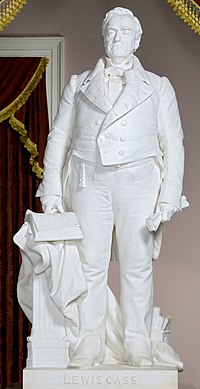
Daniel Chester French was an American sculptor of the late nineteenth and early twentieth centuries. He is best known for his 1874 sculpture The Minute Man in Concord, Massachusetts, and his 1920 monumental statue of Abraham Lincoln in the Lincoln Memorial in Washington, D.C.

Lewis Cass was an American military officer, politician, and statesman. He represented Michigan in the United States Senate and served in the Cabinets of two U.S. Presidents, Andrew Jackson and James Buchanan. He was also the 1848 Democratic presidential nominee. A slave owner himself, he was a leading spokesman for the doctrine of popular sovereignty, which held that the people in each territory should decide whether to permit slavery.

Felix Weihs de Weldon was an American sculptor. His most famous pieces include the United States Marine Corps War Memorial in the Arlington National Cemetery, Virginia, US, and the Malaysian National Monument (1966) in Kuala Lumpur.
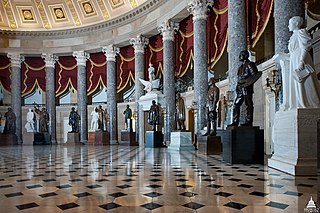
The National Statuary Hall is a chamber in the United States Capitol devoted to sculptures of prominent Americans. The hall, also known as the Old Hall of the House, is a large, two-story, semicircular room with a second story gallery along the curved perimeter. It is located immediately south of the Rotunda. The meeting place of the U.S. House of Representatives for nearly 50 years (1807–1857), after a few years of disuse it was repurposed as a statuary hall in 1864; this is when the National Statuary Hall Collection was established. By 1933, the collection had outgrown this single room, and a number of statues are placed elsewhere within the Capitol.

Edward Clark Potter was an American sculptor best known for his equestrian and animal statues. His most famous works are the marble lions, nicknamed Patience and Fortitude, in front of the New York Public Library Main Branch

Frederick Wellington Ruckstull, German: Friedrich Ruckstuhl was a French-born American sculptor and art critic.

Charles Henry Niehaus was an American sculptor.

Randolph Rogers was an American Neoclassical sculptor. An expatriate who lived most of his life in Italy, his works ranged from popular subjects to major commissions, including the Columbus Doors at the U.S. Capitol and American Civil War monuments.

Franklin Bachelder Simmons was a prominent American sculptor of the nineteenth century. Three of his statues are in the National Statuary Hall Collection, three of his busts are in the United States Senate Vice Presidential Bust Collection, and his statue of Ulysses S. Grant is in the United States Capitol Rotunda.

Gaetano Trentanove was an Italian and American sculptor.
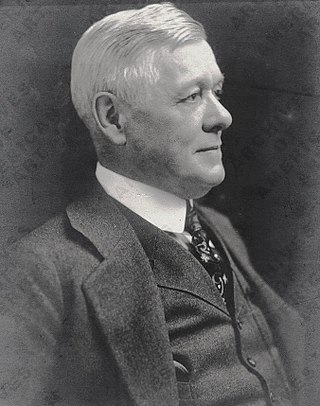
John Massey Rhind was a Scottish-American sculptor. Among Rhind's better known works is the marble statue of Dr. Crawford W. Long located in the National Statuary Hall Collection in Washington D.C. (1926).

Andrew O'Connor was an American-Irish sculptor whose work is represented in museums in America, Ireland, Britain and France.

Henry Brockholst Ledyard Sr. was the mayor of Detroit, Michigan, and a state senator, briefly served as assistant secretary under Secretary of State Lewis Cass, and was the president of the Newport Hospital and the Redwood Library in Newport, Rhode Island.
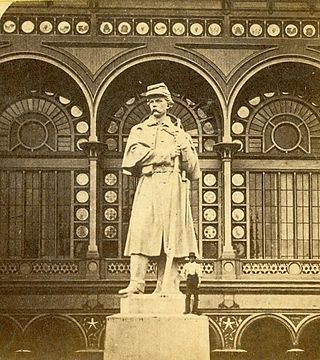
Carl H. Conrads was an American sculptor best known for his work on Civil War monuments and his two works in the National Statuary Hall Collection at the U.S. Capitol in Washington, D.C. He was also known as Charles Conrads.
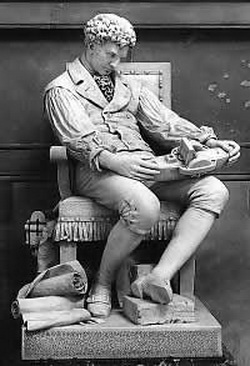
Robert Fulton is a marble sculpture depicting the American engineer and inventor of the same name by Howard Roberts, installed at the United States Capitol's National Statuary Hall, in Washington, D.C., as part of the National Statuary Hall Collection. The statue was gifted by the U.S. state of Pennsylvania in 1889.

Robert M. La Follette Sr. is a 1929 marble sculpture of Robert M. La Follette by Jo Davidson, installed in the United States Capitol, in Washington, D.C., as part of the National Statuary Hall Collection. It is one of two statues donated by the state of Wisconsin. The statue was accepted in the collection by Senator John J. Blaine on April 25, 1929.

John James Ingalls is a 1905 marble sculpture of the politician of the same name by Charles Henry Niehaus, installed in the United States Capitol, in Washington, D.C., as part of the National Statuary Hall Collection. It was one of two statues donated by the state of Kansas. The statue was accepted in the collection by Senator Arthur P. Gorman on January 21, 1905. On July 27, 2022, it was replaced by a Statue of Amelia Earhart.
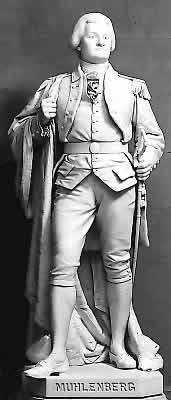
Peter Muhlenberg, or John Peter Gabriel Muhlenberg, is an 1889 marble sculpture depicting the American clergyman, soldier, and politician of the same name by Blanche Nevin, installed in the United States Capitol's crypt, in Washington, D.C., as part of the National Statuary Hall Collection. It is one of two statues donated by the state of Pennsylvania. The statue was accepted into the collection on February 28, 1889, by Pennsylvania Congressman Daniel Ermentrout.

Roger Williams is an 1872 marble sculpture of Roger Williams by Franklin Simmons, installed in the United States Capitol, in Washington, D.C., as part of the National Statuary Hall Collection. It is one of two statues donated by the state of Rhode Island. The sculpture was unveiled by Senator William Sprague of Rhode Island on January 9, 1872.

Adam Hollier is the director of the Michigan Veterans Affairs Agency and was appointed by Gov. Gretchen Whitmer. Hollier served in the Michigan Senate, representing the 2nd Senate district, serving Wayne County including Detroit, the Grosse Pointes, Hamtramck, Harper Woods, and Highland Park from 2018 to 2022.
